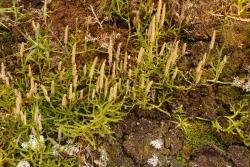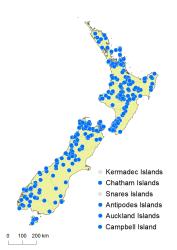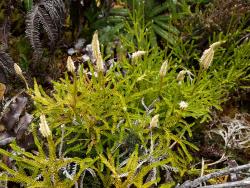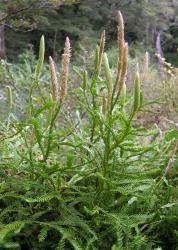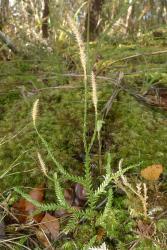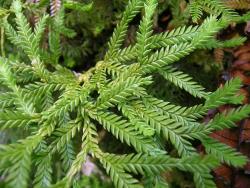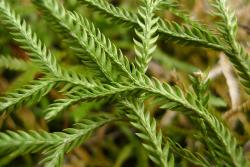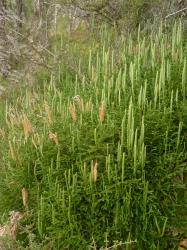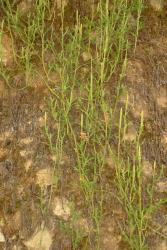- Taxon
- Gallery
- ≡ Stachygynandrum scariosum (G.Forst.) P.Beauv., Prodr. Aethéogam. 114 (1805)
- ≡ Diphasium scariosum (G.Forst.) Rothm., Feddes Repert. Spec. Nov. Regni Veg. 54: 65 (1944)
- = Lycopodium decurrens R.Br., Prodr. Fl. Nov. Holland. 165 (1810)
- ≡ Lycopodium scariosum var. decurrens (R.Br.) Hook., Cent. Ferns t. 166 (1854)
- ≡ Diphasium decurrens (R.Br.) Holub, Folia Geobot. Phytotax. 20: 78 (1985)
- = Lycopodium lessonianum A.Rich., Essai Fl. Nouv.-Zél., 59 (1832)
- = Lycopodium distans Colenso, Trans. & Proc. New Zealand Inst. 20: 236 (1888)
Horizontal stems dichotomously branching, prostrate or scrambling above ground, 1.1–3.0 mm diameter, bearing roots at intervals; leaves spirally arranged, appressed or spreading, linear or narrowly ovate, adnate. Aerial stems erect or ascending, more or less flattened in one plane, branching monopodial, glabrous; longest fertile stems 45–600 mm long (including strobili), 10–220 mm wide; unbranched portion of stem 5–100 mm long, branched portion 40–500 mm long. Sterile leaves dimorphic, flattened in one plane, with 2 rows of larger lateral leaves and 2–3 rows of smaller ventral leaves, yellow-green; lateral leaves sigma-shaped, apices acute, margins entire, bases decurrent, 2.3–5.0 mm long, 0.8–1.5 mm wide, tending to curl upwards; ventral leaves linear or narrowly elliptic, apices acuminate, those near branch apices with scarious tips, margins entire, bases adnate to subpeltate, 2.0–3.0 mm long, 0.4–0.6 mm wide. Sporophylls appressed when young, spreading at maturity, ovate to broadly ovate, apices acuminate with long, scarious tips, 2.8–5.0 mm long, 1.1–2.2 mm wide, with coloured centres and minutely erose, membranous margins, bases subpeltate, aggregated into strobili. Strobili solitary or in pairs, erect, yellow to orange-brown, 7–63 mm long, 5–9 mm wide, borne on short-leaved stalks; stalks 10–195 mm long, terminal on aerial branches, erect, bearing leaves in rough whorls that are shorter than either the sterile leaves elsewhere on the aerial stems or the sporophylls.
Lycopodium scariosum is a scrambling plant. It is one of two species of New Zealand Lycopodiaceae that have branches bearing dimorphic sterile leaves flattened in one plane. There are two rows of larger, lateral leaves and additional rows of linear leaves on the ventral surface only. It is easily distinguished from L. volubile, which also has flattened branches and dimorphic leaves, but has smaller linear leaves on both the ventral and dorsal surfaces. Lycopodium scariosum is further distinguished from L. volubile by its solitary, erect strobili borne on stalks.
North Island: Northland, Auckland, Volcanic Plateau, Gisborne, Taranaki, Southern North Island.
South Island: Western Nelson, Sounds-Nelson, Marlborough, Westland, Canterbury, Otago, Southland, Fiordland.
Chatham Islands, Stewart Island, Antipodes Island, Auckland Islands, Campbell Island.
Altitudinal range: 0–1430 m.
Lycopodium scariosum occurs in lowland to montane regions of the North Island from the Tutamoe Range south to Wellington, extending locally into subalpine areas. It mostly grows in a zone from 300 to 1000 m, but occurs up to 1300 m in the Kaimanawa Ranges, and down to near sea level in some northern localities. In the South Island it occurs in lowland and montane areas, extending locally into subalpine areas, reaching 1430 m in the St Arnaud Range. It is absent only from some parts of inland Otago and is rare in eastern Marlborough and Canterbury. It has been recorded from Banks Peninsula (Wilson 2013), but no herbarium specimens have been located. It extends to the Chatham Islands, Stewart Island and all the subantarctic islands except the Snares.
Also Borneo, Philippines, New Guinea, Australia (Victoria, Tasmania).
Lycopodium scariosum occurs in open beech and podocarp/broadleaved forest, on forest margins and in clearings, under mānuka and kānuka, in subalpine scrub and tussockland, and on pākihi soils. It is a scrambling species that is commonly found on roadside cuttings and banks, on track banks, river banks, rocky ground, scree margins, and around boggy areas and tarns.
2n = 60 (de Lange et al. 2004).



